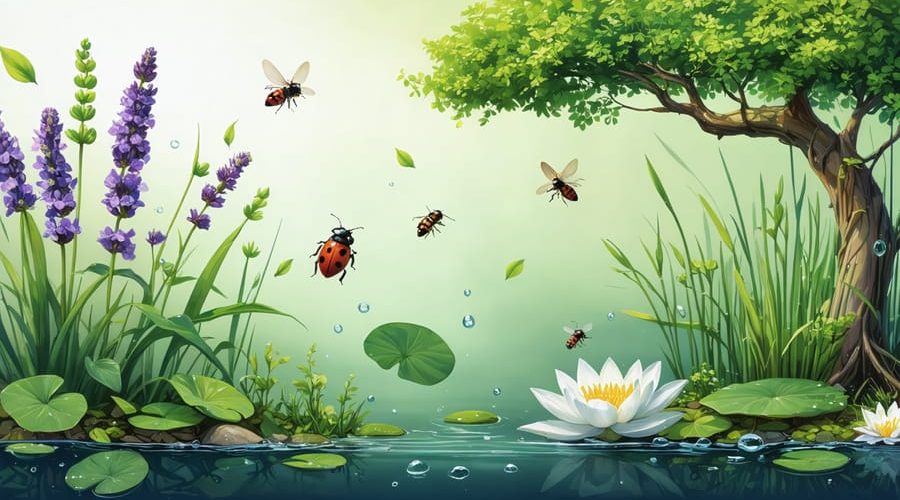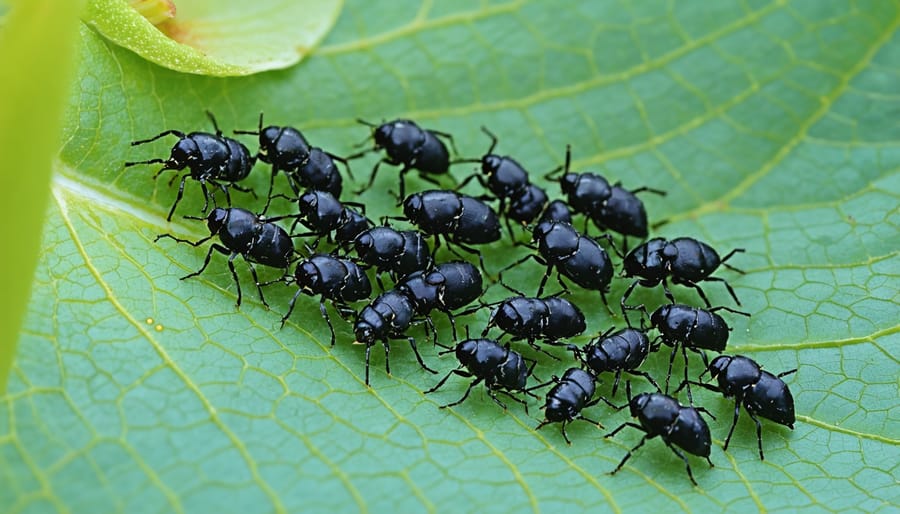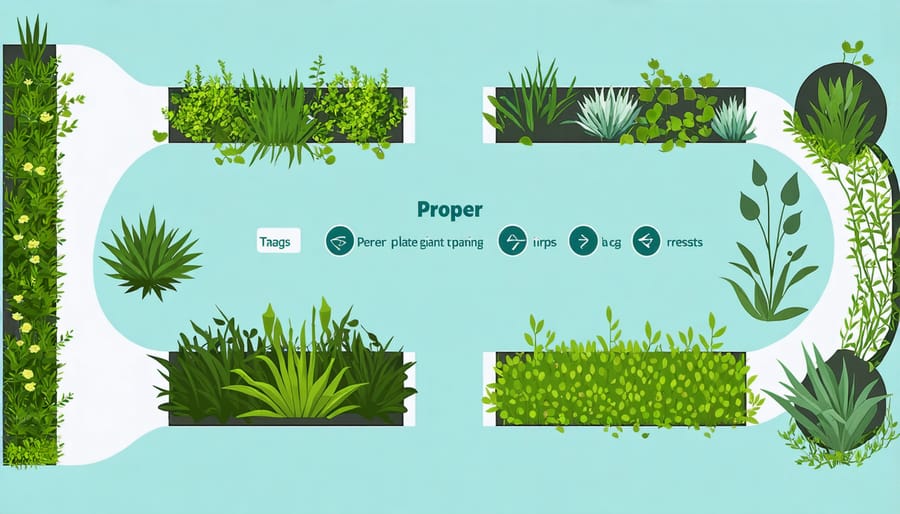
Naturally Control Aphids in Your Water Garden (Without Harming Fish)
Combat aphids effectively while protecting your aquatic ecosystem through integrated pest management – a balanced approach that combines prevention, biological control, and targeted intervention. These tiny sap-sucking insects can quickly multiply and damage water garden plants, but harsh chemical treatments risk harming beneficial insects and fish. Natural predators like ladybugs and lacewings, coupled with companion planting using aromatic herbs, create a sustainable defense against aphid infestations. Regular monitoring and early intervention allow gardeners to maintain healthy water gardens without disrupting the delicate balance of their aquatic environment.
Monitor plant stems and leaf undersides weekly for early signs of aphid colonies, focusing on new growth where these pests first appear. Remove affected leaves by hand, spray plants with a gentle stream of water to dislodge aphids, or introduce beneficial insects as natural controls. When necessary, apply fish-safe insecticidal soaps or neem oil solutions, carefully following dilution guidelines to protect aquatic life. This multi-faceted approach ensures long-term aphid control while preserving the health and beauty of your water garden ecosystem.
Understanding Aphids in Water Gardens
Common Aphid Species in Aquatic Plants
In water gardens, you’ll commonly encounter several aphid species that have adapted to aquatic environments. The water lily aphid (Rhopalosiphum nymphaeae) is the most frequent visitor, appearing as small greenish-black insects that cluster on lily pads and flower stems. These persistent pests particularly love water lilies, lotus, and other floating-leaved plants.
The black bean aphid (Aphis fabae) also makes appearances in water gardens, especially on marginal plants like iris and rushes. While primarily dark in color, they can sometimes show up in varying shades of green or brown. Keep an eye out for the green peach aphid (Myzus persicae) too – they’re particularly fond of tender new growth on emerging aquatic plants in spring.
Less common but still noteworthy is the watercress aphid (Rhopalosiphum nasturtii), which tends to favor plants in shallow water areas. These tiny pests are usually pale green and can quickly multiply on emergent vegetation.
Remember that identifying these species correctly helps you choose the most effective control methods while protecting your aquatic ecosystem’s delicate balance.
Signs of Aphid Infestation
Early detection of aphids can save your garden from extensive damage. Watch for clusters of tiny insects, usually green, black, or brown, gathering on the undersides of leaves and along plant stems. You might notice leaves becoming curled, yellowed, or distorted – this is often the first sign of an aphid problem.
Another telltale indicator is the presence of sticky honeydew, a sweet substance that aphids excrete. This sticky residue often leads to black sooty mold growth on leaves and stems. Keep an eye out for ants, too – they’re attracted to honeydew and their increased activity around plants can signal an aphid infestation.
Regular plant inspections are crucial, especially during spring and early summer when aphid populations typically explode. Pay special attention to new growth, as aphids particularly love tender, fresh shoots. If you notice your plants looking wilted despite adequate watering, or see a general decline in plant vigor, check carefully for these pests.
Remember, a few aphids aren’t necessarily cause for alarm, but catching an infestation early makes control much easier and more effective.

Fish-Safe Prevention Strategies
Plant Selection and Spacing
Smart plant selection and spacing is one of the most effective ways to prevent pest infestations before they start. Choose plants known for their natural resistance to aphids, such as lavender, rosemary, and marigolds, which can be planted around the edges of your water garden. These plants not only deter aphids but also attract beneficial insects that feed on them.
When arranging your water garden plants, maintain proper spacing to improve air circulation and reduce humidity levels that aphids love. A good rule of thumb is to leave 12-18 inches between plants, depending on their mature size. This spacing also makes it easier to spot and treat any aphid problems early on.
Consider creating companion planting zones by mixing aphid-resistant plants with more susceptible ones. For example, plant chives or garlic near roses, as their strong scent naturally repels aphids. You can also incorporate beneficial flowering plants like alyssum or dill, which attract ladybugs and other natural aphid predators.
Remember to regularly monitor new growth, as aphids particularly love tender, fresh shoots. Trim back overcrowded areas and remove any yellowing or weak plants that might attract pests. By thoughtfully selecting and arranging your plants, you’ll create a naturally resilient water garden that’s less appealing to aphids.

Natural Barriers and Companion Plants
Creating natural barriers and planting companion plants is one of the most effective ways to protect your garden from aphids. Marigolds, nasturtiums, and calendula act as excellent trap crops, attracting aphids away from your valuable plants. Plant these sacrificial companions around the perimeter of your garden or interspersed between your primary plants.
Strong-smelling herbs like lavender, mint, garlic, and chives naturally repel aphids while adding beauty and functionality to your garden. Consider creating an herb border around vulnerable plants or incorporating these aromatic defenders throughout your garden beds. Just remember that mint can be invasive, so plant it in containers to keep it controlled.
Interplanting with alliums (onions, garlic, chives) provides additional protection, as aphids dislike their pungent odor. Dill and fennel not only deter aphids but also attract beneficial insects like ladybugs and parasitic wasps that feed on aphids. Plant these beneficial attractors strategically throughout your garden.
Physical barriers like row covers or fine mesh netting can protect young plants during the most vulnerable growth stages. Remove these covers once plants flower to allow for pollination. Maintain good air circulation between plants by proper spacing and pruning, as crowded conditions can create favorable environments for aphid populations to thrive.
Safe Control Methods
Biological Controls
Nature provides some of the most effective solutions for aphid control through beneficial organisms in water gardens. Ladybugs, lacewings, and parasitic wasps are particularly effective predators that naturally keep aphid populations in check. These helpful insects can be purchased from garden centers or attracted to your garden by planting specific flowers like dill, fennel, and yarrow nearby.
Praying mantises are another excellent ally in aphid control, as they’ll eagerly consume these pests while adding an interesting element to your garden. Hoverflies, both in their adult and larval stages, are voracious aphid predators that can be attracted by planting shallow-flowering plants around your water garden.
Before introducing any new organisms, it’s important to understand proper biological control considerations. Ensure that any beneficial insects you introduce are native to your area and won’t become invasive themselves. It’s also crucial to maintain a diverse habitat that supports these beneficial insects throughout their lifecycle.
Remember that establishing a healthy population of natural predators takes time, but the long-term benefits of this sustainable approach far outweigh any short-term inconvenience. Regular monitoring of both pest and beneficial insect populations will help you gauge the effectiveness of your biological control strategy.

Manual Removal Techniques
One of the most effective and environmentally friendly ways to control aphids is through manual removal. Start by inspecting your plants regularly, paying special attention to the undersides of leaves where aphids commonly gather. You can gently wipe them off using your fingers while wearing gardening gloves, or blast them with a strong stream of water from your garden hose.
For delicate plants, use a soft-bristled brush to sweep aphids away. This method works particularly well for concentrated infestations. Another helpful technique is to prune heavily infested leaves or stems, ensuring you dispose of them in a sealed bag to prevent the aphids from returning to your garden.
When using the water spray method, direct the stream upward from beneath the leaves for best results. Morning is the ideal time for this technique, allowing plants to dry before evening and reducing the risk of fungal problems. For smaller plants, you can also use a spray bottle filled with plain water for more precise control.
Remember to check for beneficial insects like ladybugs before removing aphids, as these natural predators help control pest populations. After manual removal, monitor your plants daily for a few weeks to catch any returning aphids early. This consistent attention helps prevent large-scale infestations from developing.
Aquatic-Safe Solutions
When treating aphids near water features, it’s crucial to use solutions that won’t harm your aquatic ecosystem. Fortunately, there are several effective chemical-free pond treatments that keep both your plants and aquatic friends healthy.
A simple spray made from neem oil diluted with water (1 tablespoon per gallon) works wonders on aphids while remaining safe for pond life. Just be careful to spray directly on affected plants and avoid overspray into the water. Another gentle yet effective option is insecticidal soap specifically formulated for aquatic environments – look for products labeled as fish-safe.
Garlic spray is a fantastic natural deterrent that won’t upset your pond’s balance. Simply blend three cloves with a cup of water, strain, and spray affected areas. For extra power, add a few drops of liquid seaweed. This solution not only repels aphids but also provides nutrients to your plants.
Remember to apply these treatments during early morning or evening hours when beneficial insects are less active. Always test any solution on a small area first and monitor your pond inhabitants for any adverse reactions. With consistent application of these gentle treatments, you can maintain healthy water gardens while keeping pesky aphids at bay.
Successfully managing aphids in your garden requires a thoughtful, multi-faceted approach that combines prevention, monitoring, and targeted intervention. By implementing the integrated pest management strategies we’ve discussed, you can effectively control aphid populations while maintaining a healthy, balanced garden ecosystem.
Remember that regular monitoring is your first line of defense. Make it a habit to inspect your plants at least twice a week, paying special attention to new growth, leaf undersides, and stem joints where aphids commonly gather. Early detection allows you to address infestations before they become severe, making control measures more effective and less intensive.
The key to success lies in combining different control methods rather than relying on a single approach. Start with cultural controls like proper plant spacing and maintaining optimal growing conditions. Encourage beneficial insects by planting flowers and herbs that attract natural predators. When intervention is necessary, begin with the gentlest methods first, such as water sprays or hand-removal, before moving on to stronger treatments like insecticidal soaps or neem oil.
Stay committed to your monitoring schedule even after you’ve successfully controlled an aphid outbreak. These persistent pests can return quickly, especially during favorable conditions. Keep detailed notes about when and where you spot aphids, which control methods work best, and any patterns you notice throughout the growing season.
Most importantly, remember that some aphid presence is normal and doesn’t always require intervention. The goal isn’t to eliminate every single aphid but to maintain populations below damaging levels. By staying vigilant and responding appropriately to changes in pest populations, you can protect your garden while preserving beneficial insects and natural balance.
With consistent monitoring and a flexible approach to control methods, you’ll develop an effective, sustainable strategy for managing aphids in your garden. Your efforts will result in healthier plants and a more resilient garden ecosystem overall.
